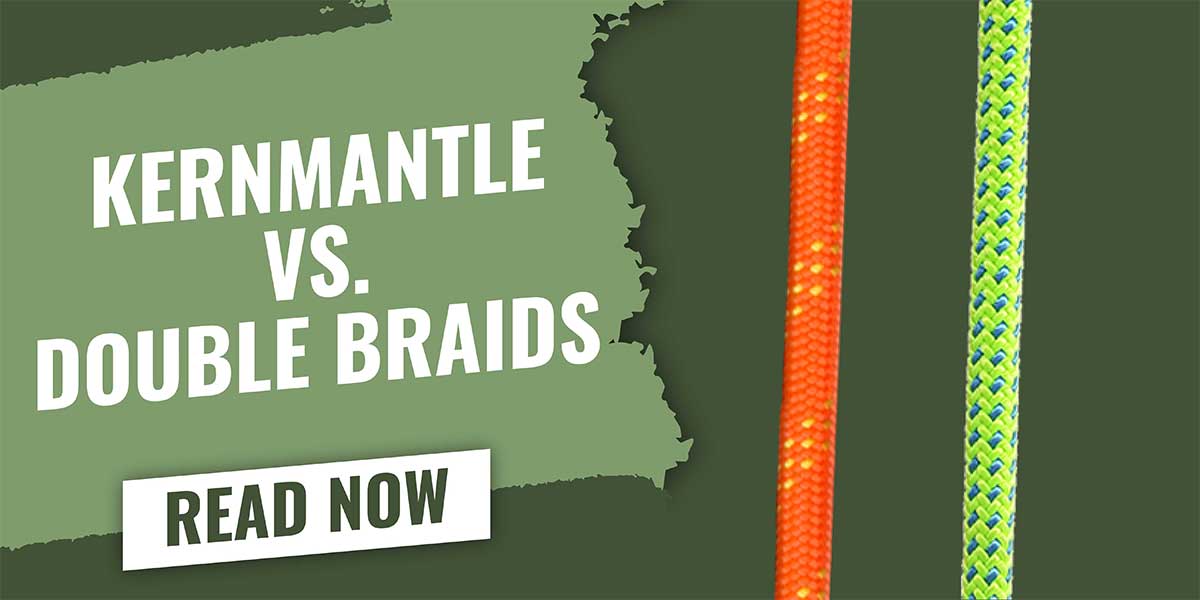
Kernmantle… Double Braids…?
Kernmantle… Double Braids…?
Use this rope… no, no, no; use THIS rope! So many strands, so many colors, one has more elongation than the other; Kernmantle, Double Braids… which one is best for me? Those are a few of the dilemmas you may encounter; in today’s climate, there is an abundance of rope to choose from! It was this way for many of us too. If buying a plethora of rope isn’t in your wheelhouse, then let us help deliver thou some guidance that many of us have already found, “The One” that gets the job done! Forewarning, not everyone has the same taste in rope, as with any industry, we all have different likes and dislikes.
Kernmantle ropes, WHAT?!
This type of rope construction consists of two distinct layers: the KERN (core) and the MANTLE (sheath), and in the tree care industry, are referred to as “static” ropes. The core is what provides the rope’s strength and load-bearing capacity, while the sheath serves as a protective outer layer. This combination creates a rope that offers the best of both worlds: strength and abrasion resistance! Kernmantle ropes are widely used in climbing, mountaineering, TREE CLIMBING, rope rescue, along with various outdoor activities. There are some characteristics that set kernmantle ropes apart from others.
- Core and Sheath: The core of a kernmantle rope is typically made from strong materials like nylon or polyester fibers. The sheath is meant to be a protective layer, shielding the core from abrasion, UV exposure, and other external factors. Kernmantle ropes tend to be at 32 or 42 strand count ropes, although there are some exceptions to this.
- Strength: Kernmantle ropes are known for their excellent strength-to-weight ratio. These ropes are generally low elongation. With that being said, kernmantle ropes aren’t intended to absorb shock loads.
- Core Construction: The core fibers are twisted into an S or Z Twist pattern and then lined up parallel to each other. However, as technology advances so does everything around us which leads us to a certain manufacturer having X-Braid core technology. But only a certain manufacturer at the moment, uses this X-Braid tech.
- Intended for SRS/SRT climbing purposes due to the low elongation of the rope.
-
MILKING: We’ve all seen the sheath come apart from the core on double braid ropes. Well, kernmantle tends to have little-to-no milking.
Double Braid Ropes
Double braid ropes are, in the tree care industry, considered “dynamic” and have a braided sheath, and a braided core so that with being said; it’s a rope inside of a rope. It is said that the load is distributed between cover and core evenly but that’s just the consensus to them. Unlike their kernmantle counterparts, double braid ropes CAN be spliced. But why would you want a splice? Splices streamline your climbing system and reduces the margin for error by eliminating the need for a termination knot.
Dual Purpose
Double braids offer the user the ability to use both MRS and SRS climbing styles. On the flipside, double braids tend to have more dynamic properties to them, meaning that they have a higher elongation than kernmantle ropes. There is the “bounce” that one must consider when climbing on these ropes, more or less on ascent. Once you get climbing and traversing the crown, it really isn’t too noticeable. But how often are you really racing up the tree… at work?! Not all double braids have the same elongation, so doing a bit of research may be necessary prior to buying one of these.
Will it Milk?
Yes and no. There are double braids that claim they don’t milk but if yours does, that doesn’t mean the rope is no longer good to use. Tape at the point where the core is still married to the cover and cut the bitter that is just cover. Once you have done so, burn the end to prevent any further fraying and you may continue to enjoy the rope, so long as it still passes inspection.
Dynamic and Static?
Now, I did mention those two specific words while describing the construction of the two ropes. But what does it mean? In the tree care world, we use the word static when referring to kernmantle ropes and dynamic for double braid ropes, however by definition, our climbing ropes are considered low elongation. A low-stretch rope is that of having elongation greater than 6% and less than 10% at 10% of its minimum breaking strength. While a static rope is that of having elongation less than 6% of its minimum breaking strength.
Hmm, just some food for thought!

Leave a comment